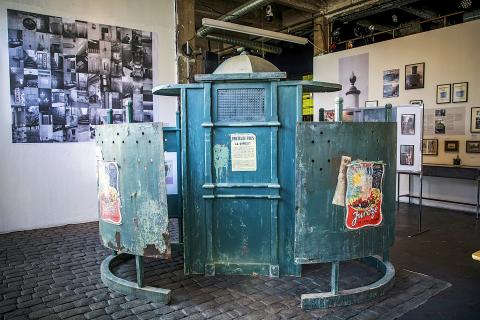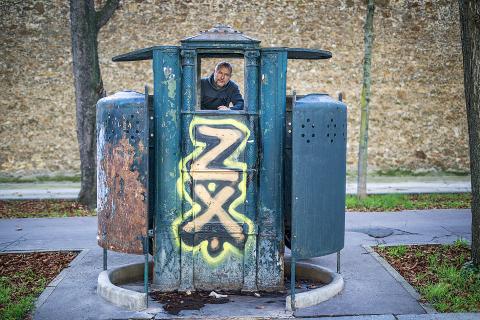They were as much a symbol of Paris as croissants and the Eiffel Tower, though they had more than a whiff of scandal from the start.
Now the much-mourned “pissotieres,” the dark-green public urinals that gave relief to generations of Parisian men, are finally getting their place in the city’s social and architectural history.
The first-ever exhibition in the French capital dedicated to the once ubiquitous and notorious facilities opened on Wednesday.

Photo: EPA-EFE
But the metropolis which invented the on-street urinal had an ambivalent attitude towards them from the unbuttoning of the first fly, curator Marc Martin said.
The one-man originals — with a rather phallic peppermill design — were quickly christened “Rambuteau’s columns” after the aristocratic city official who commissioned them in 1834.
Scandalized at the double entendre, “Monsieur Clean,” as he was nicknamed, tried to give the urinals a grander air by calling them “vespasiennes” after the Roman emperor Vespasian who once taxed urine — which the ancients use to bleach their togas.

Photo: EPA-EFE
But the pissotieres’ success quickly spawned three, six and eight-man versions — and that is when the fun began, laughed Martin, an artist and photographer who is a specialist on forgotten urban underworlds.
“They rapidly became places for hookups that would be impossible anywhere else. Generations of [gay] men were emancipated in them,” he said.
SPIES AND SUBTERFUGE
But beyond the gay world, they also played a pivotal role in French history as a place of secrets and subterfuge, used by spies to make drops and by Resistance fighters to pass messages and weapons out of sight from the Nazi occupiers during World War II. Some of the disinformation that fueled the anti-Semitic Dreyfus Affair, which rocked France at the turn of the 20th century, was spread through the pissotieres, Martin found through a decade of research.
But it was their reputation for illicit encounters that piqued the interest and the pens of writers from Verlaine and Rimbaud to Celine.
Some scholars even believe Proust may have enjoyed pongy pleasures in their stalls.
Martin said they were “an incredible vector in social and sexual mixing,” particularly the three-man version, where the man in “the highly strategic middle stall was usually there to do everything but go to the toilet.”
Martin said his own fascination with them — he has also written an acclaimed book on the subject — began because he had the “first sensations” about his own sexuality “just as they were being closed down” in the early 1980s.
LIKE SMELL, SCANDAL LINGERS
Only one remains in Paris, just outside the walls of the Sante prison, an unconscious symbolic warning, Martin insisted, “of where your behavior might land you.”
Like their ripe smell, the taboo lingers, with all of the city’s major museums holding their noses at the idea of staging the show, which has found a home at the Point Ephemere arts space by the trendy Canal St Martin.
The show will travel to New York’s Leslie-Lohman Museum of Art next year after already having an extended run at the Schwules Museum in Berlin.
“It’s a shame to sweep this little human story under the carpet,” Martin said. Despite endless campaigns for their closure on grounds of “social hygiene,” pissotieres were a potent if smelly symbol of the City of Lights, he said.
Hollywood legend Alfred Hitchcock — whose Psycho offered the first footage of a flushing toilet in a mainstream Hollywood film — was a fan, insisting on meeting journalists at one for his interviews during a 1969 Paris visit.
The exhibition also includes touching testimony from the urinals’ former users, including one old man who admits for the first time that he met his life’s partner in one.
‘SUCH AN ADVENTURE!’
Another, 73-year-old Jean-Pierre, was positively misty-eyed about them.
“I was touched up by dancers, fashion designers, actors and singers in them... You could meet someone in a smelly urinal and a few minutes later be in their sumptuous apartment. It was such an adventure!”
An attempt last year to revive “pissoirs” on the streets of Paris to stop men from urinating against walls — a perennial problem — was quashed by feminists who argued they were sexist because none were adapted for women.
T’was ever so, said Martin, who said women have been “long forgotten” in the history of public lavatories.
In keeping with pissotiere tradition, and Paris city hall’s policy of free public toilets, the exhibition is open to all. You don’t have to spend a penny, joked Martin: “We could not have had it any other way.”

June 23 to June 29 After capturing the walled city of Hsinchu on June 22, 1895, the Japanese hoped to quickly push south and seize control of Taiwan’s entire west coast — but their advance was stalled for more than a month. Not only did local Hakka fighters continue to cause them headaches, resistance forces even attempted to retake the city three times. “We had planned to occupy Anping (Tainan) and Takao (Kaohsiung) as soon as possible, but ever since we took Hsinchu, nearby bandits proclaiming to be ‘righteous people’ (義民) have been destroying train tracks and electrical cables, and gathering in villages

Swooping low over the banks of a Nile River tributary, an aid flight run by retired American military officers released a stream of food-stuffed sacks over a town emptied by fighting in South Sudan, a country wracked by conflict. Last week’s air drop was the latest in a controversial development — private contracting firms led by former US intelligence officers and military veterans delivering aid to some of the world’s deadliest conflict zones, in operations organized with governments that are combatants in the conflicts. The moves are roiling the global aid community, which warns of a more militarized, politicized and profit-seeking trend

The wide-screen spectacle of Formula One gets a gleaming, rip-roaring workout in Joseph Kosinski’s F1, a fine-tuned machine of a movie that, in its most riveting racing scenes, approaches a kind of high-speed splendor. Kosinski, who last endeavored to put moviegoers in the seat of a fighter jet in Top Gun: Maverick, has moved to the open cockpits of Formula One with much the same affection, if not outright need, for speed. A lot of the same team is back. Jerry Bruckheimer produces. Ehren Kruger, a co-writer on Maverick, takes sole credit here. Hans Zimmer, a co-composer previously, supplies the thumping

Dr. Y. Tony Yang, Associate Dean of Health Policy and Population Science at George Washington University, argued last week in a piece for the Taipei Times about former president Ma Ying-jeou (馬英九) leading a student delegation to the People’s Republic of China (PRC) that, “The real question is not whether Ma’s visit helps or hurts Taiwan — it is why Taiwan lacks a sophisticated, multi-track approach to one of the most complex geopolitical relationships in the world” (“Ma’s Visit, DPP’s Blind Spot,” June 18, page 8). Yang contends that the Democratic Progressive Party (DPP) has a blind spot: “By treating any